Additional Information
Book Details
Abstract
Drawing on case studies from Ethiopia, Sudan, Chad, Mali and Kenya (focusing on Turkana district) during the drought years of 1990-91, this book investigates why early warning signals were not translated into timely intervention. It examines, for the first time, the role of early warning information in decision-making processes, particularly within key donor agencies. The book concludes with practical policy recommendations, on who 'owns' early warning information, how it is used and looks at how to speed up the logistics of emergency relief.
Table of Contents
| Section Title | Page | Action | Price |
|---|---|---|---|
| Contents | 5 | ||
| LIST OF TABLES | 8 | ||
| LIST OF FIGURES | 9 | ||
| ACKNOWLEDGEMENTS | 10 | ||
| ACRONYMS | 11 | ||
| 1: The Missing Link | 15 | ||
| Introduction | 15 | ||
| Understanding famine | 17 | ||
| Early warning | 18 | ||
| Famine prevention: the relief response | 19 | ||
| The Sahel and Horn of Africa: conditions ripe for famine | 20 | ||
| The actors | 22 | ||
| Conclusions | 24 | ||
| 2: What are Famine Early-warning Systems? | 26 | ||
| Introduction | 26 | ||
| EWS as information systems | 26 | ||
| Information generated by EWS | 29 | ||
| Use of EW information | 32 | ||
| Constraints to the use of EW information | 33 | ||
| Conclusions | 38 | ||
| 3: The International Relief System | 40 | ||
| Introduction | 40 | ||
| Preventing famine: whose responsibility? | 41 | ||
| What is the international relief system? | 42 | ||
| Profile of four donor agencies | 44 | ||
| The political context of emergency aid to Africa in 1990-91 | 47 | ||
| Sources of EW information used by donor agencies | 50 | ||
| Influence of the media | 55 | ||
| Influence of formal political channels | 57 | ||
| Making decisions about the relief response | 58 | ||
| Executing decisions: the relief response | 62 | ||
| Donor co-ordination | 64 | ||
| Conclusions | 65 | ||
| 4: Ethiopia | 69 | ||
| Introduction | 69 | ||
| Food security | 71 | ||
| The EW/response system | 75 | ||
| The story of EW/response in 1990-91 | 80 | ||
| Evaluating the EW information | 85 | ||
| Use of EW information | 88 | ||
| Implications for the final response | 91 | ||
| Insecurity and the EW/response process | 92 | ||
| Conclusions | 94 | ||
| 5: Sudan | 98 | ||
| Introduction | 98 | ||
| Food security in north Sudan, focusing on Darfur | 100 | ||
| The EW/response system | 102 | ||
| The story of EW/response in 1990-91 | 105 | ||
| Evaluating the EW information | 111 | ||
| Use of EW information | 114 | ||
| Implications for the final response | 119 | ||
| Insecurity and the EW/response process | 120 | ||
| Conclusions | 121 | ||
| 6: Chad | 125 | ||
| Introduction | 125 | ||
| Food security | 127 | ||
| The EW/response system | 130 | ||
| The story of EW/response in 1990-91 | 133 | ||
| Evaluating the EW information | 138 | ||
| Use of EW information | 142 | ||
| Implications for the final response | 148 | ||
| Insecurity and the EW/response process | 149 | ||
| Conclusions | 149 | ||
| 7: Mali | 153 | ||
| Introduction | 153 | ||
| Food security | 155 | ||
| The EW/response system | 158 | ||
| The story of EW in 1990-91 | 162 | ||
| Evaluating the EW information | 165 | ||
| The story of response in 1990-91 | 165 | ||
| Use of EW information | 169 | ||
| Implications for the final response | 170 | ||
| Insecurity and the EW/response process | 173 | ||
| Conclusions | 174 | ||
| 8: Turkana District, Kenya | 179 | ||
| Introduction | 179 | ||
| Food security | 181 | ||
| The EW response system | 189 | ||
| The Emergency Livestock Purchase Scheme: 1990 | 192 | ||
| Food crisis and food-for-work in Kakuma Division: 1991 | 195 | ||
| District-wide drought in 1992 | 197 | ||
| Evaluating the EW information | 199 | ||
| Use of EW information | 203 | ||
| Implications for the final response in 1990 and 1991 | 207 | ||
| Insecurity and the EW/response process | 210 | ||
| Conclusions | 211 | ||
| 9: Forging the Link | 216 | ||
| Introduction | 216 | ||
| EWS are necessary | 218 | ||
| Common patterns in how EW information is used | 219 | ||
| Forging the link | 222 | ||
| GENERAL REFERENCES | 226 | ||
| CASE-STUDY REFERENCES | 228 | ||
| Ethiopia | 228 | ||
| Sudan | 230 | ||
| Chad | 231 | ||
| Mali | 232 | ||
| Turkana District, Kenya | 233 | ||
| INDEX | 235 |
